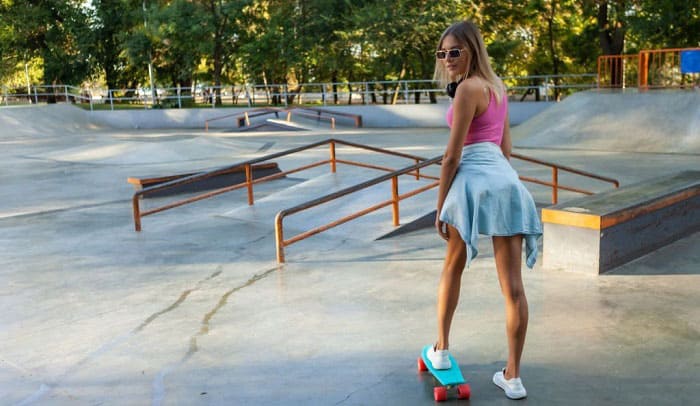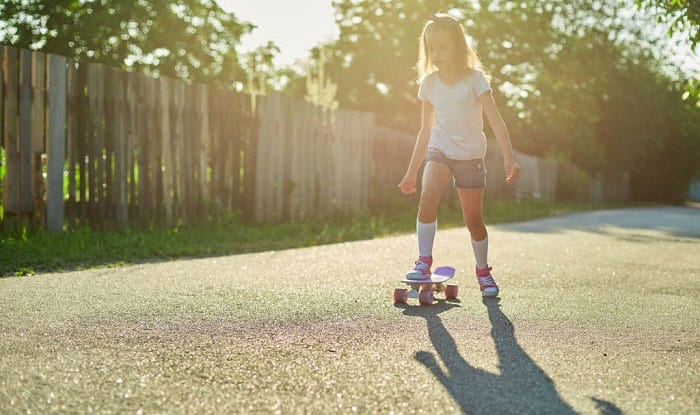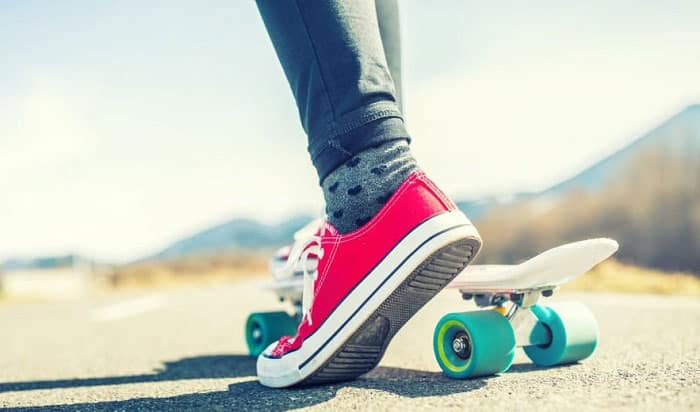Believe it or not, most of us always have spare time even when we think that our schedule is too tight to indulge in leisure. We make sure that we still get those “me times” during the day.
Maybe you happen to find yourself doing nothing on a summer afternoon, your feet are itching to be somewhere, yet you don’t want to do anything usual. In that case, why not learn how to ride a cruiser board? You might think it’s tricky, but fear not, for we are here to help you!
Table of Contents
What You’ll Need?
Since we are here to go cruiser boarding, gear up and get yourself some fresh air ‘round the hood. We don’t need much but a cruiser board for this tutorial.
Or, if you’re being extra careful, other safety gear like a helmet and pads for your elbows and knees won’t hurt. It’s also advisable that you wear proper shoes; those that stick well with your board works best.
Step by Step
Step 1: Take a Stance
Riding a cruiser is almost the same as riding the standard skateboard. If you already know your stance, then good for you! If not, then here’s how it goes: A regular-footed rider puts their left foot forward and uses their right foot to push off the ground, while a goofy-footed rider uses his feet the other way around.
You must determine your footing because your comfort will depend on it. Obviously, we don’t want to fall or stumble.
Step 2: Kicking Things Off
Assuming your stance, lean back slightly and push using your front foot. It might feel awkward at first, but you’ll surely get the hang of it as you go.
You should move so that the front wheels lift off slightly from the ground, but do this in moderation. To maintain stability, try bending your knees a little.
Step 3: Make a Turn
This step is all about swerving. Of course, the ride around the neighborhood isn’t guaranteed to be smooth. There will always be obstacles along the way and for us to prevent unwanted encounters, let’s learn how to turn on a cruiser skateboard.
First, make sure that your feet are parallel. If you are regular-footed, lean towards the toe-edge side when turning right, then lean on the heel-edge side when turning left.
On the other hand, if you are goofy-footed, leaning towards the toe-edge side or heel-edge side will move the board to the left and right, respectively.
To avoid accidents, practice in a safe area without traffic. Additionally, make sure you got the right trucks; they should be as wide as your deck and tightened correctly.
Step 4: Stop
Lean over so you can turn your board to the side nearest you. You can use your back foot to slow down by dragging it on the ground. The friction should stop the board.
Step 5: Cruising Trainee
You’ll never go wrong with practicing. Before you hit the hustle and bustle of city streets, try skating first on a near and familiar route. You can also practice on mock obstacles such as rocks and over some realistically avoidable cracks.
Practice your stance, footing, swerving, and stopping — basically everything we’ve discussed here in our tutorial. Just ride on and get cruising!
Before You Go Cruising
- As we have mentioned earlier, there’s no harm in using protective equipment, whatever type of rider you might be. Whether you’re a beginner or a pro, safety always comes first. A helmet, knee and elbow pads, plus proper footwear will protect you from impact.
- You can’t just go skating around willy-nilly, of course! Make sure you are aware of the road regulations in your area. There are designated paths for pedestrians. Also, expect disruptive behavior from other people while on the road. Most importantly, traffic signs are there for you to abide by, not ignore.
- Be sure of your compatibility with your board. A skateboard for cruising is usually more tailored to cruising than the standard skateboard. This is true even for mini cruisers, which are more portable.
They have larger wheels for smoother rides. These wheels are also softer, thus having the ability to handle rougher surfaces.
Types of Boards
If you’re a newbie, you might get confused with the different types of skateboards and their uses. To give you a quick refresher, there are commonly three (3) types of skateboards:
- Longboards – As the name goes, these are designed for long distances, but not for tricks or fast rides. They are comfortable to use for extended periods.
- Cruiser – This type is designed for short and quick distances. It is more portable but requires a tad more effort on the balancing aspect.
- Skateboard – The popular kid. This is designed for doing tricks and speedy rides but not exactly for traveling.
Reasons Why Cruiser Board Is Beginner-friendly
1. Big, soft, cruisin’ wheels
Cruisers come with bigger and softer wheels that can withstand rougher roads and give you a smooth ride, thus the cruising. Your added weight, along with the wheels, will make the board more grippy and controllable.
2. Wide Deck
Cruising boards have more expansive decks than your typical skateboard because they are meant for a comfortable short ride. The space of the board will help you find your stance and retain your balance.
Conclusion
The cruiser board is for all ages, right? Now that you’ve learned all the necessary information on how to ride a cruiser board, you may now begin practicing and applying all the information we’ve talked about earlier.
If you find this article interesting, consider sharing it with your friends and involve them as you go on your skateboarding journey. It’s a fun recreational activity that you will certainly enjoy!

Hi, I am Charles Harris. I opened this site to write as much as I can about my biggest passion – skateboarding!
I started as a clumsy yet passionate rookie 10 years ago to now a still passionate yet much better skateboarder! But I have to tell you, the whole journey has always been fun and rewarding, indeed not without hardship.




